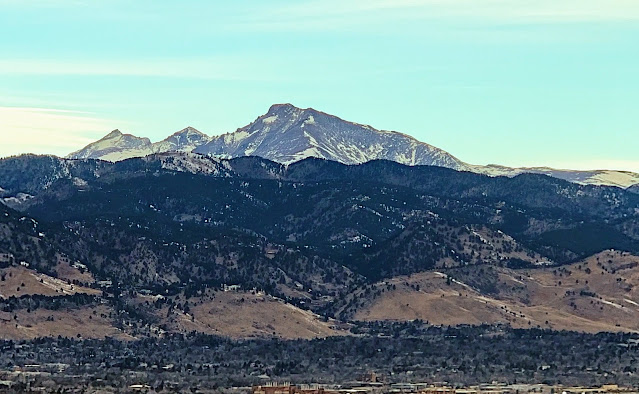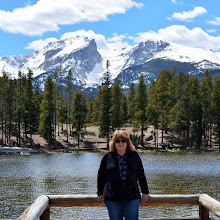Sunday, January 30, 2022
Orchid Beauty
Monday, January 24, 2022
Winter Days
This is life around here these days...slushy and icy roads, tree branches white with snow, and my husband and I working hard to clear our driveway. Nonetheless, I love winter! To me, this is the cozy season where life slows down a bit.
When I open my window shades in the morning I often see a herd of deer passing through my backyard, foraging for food.
On some days the deer fill my window views all day long!
They are inquisitive and have excellent hearing, so they look up at me when I take their photos.
They are such beautiful and graceful creatures.
For the most part, my husband and I have been hibernating at home this month as Omicron coronavirus numbers were high in our area. We had an errand to run in Boulder last week and we drove there by US Highway 36, which we have not driven on in a long time. We stopped at the "Scenic Overlook" or Davidson Mesa Overlook. It was nostalgic for us because the first time we visited Colorado nineteen years ago we stopped there to take photos. Our son was attending the University of Colorado at Boulder for his Master's Degree and we drove cross country to give him our car, as we had purchased a new one. Back then US 36 was a two-lane highway, and now with population growth in the area, it is a six-lane highway in some sections!
On a happier note, I won this wonderful cookbook Treasures of the Mexican Table, full of classic recipes and local secrets from all the states of Mexico, in a giveaway sponsored by The Book Club Cookbook. The Author, Pati Jinich, is on the PBS three-time James Beard Award and Emmy-nominated cooking show called Pati's Mexican Table. Her cookbook is full of delicious recipes from soup to desserts that I can't wait to try. Expect to see some in upcoming blog posts!
Monday, January 17, 2022
Meow Wolf Denver
Meow Wolf is an arts and entertainment company that is based in Santa Fe, New Mexico, Las Vegas, Nevada and now in Denver, Colorado! Each state's Meow Wolf is permanent and unique and consists of ultra-creative immersive and interactive experiences that transport audiences of all ages into fantastic realms of story and exploration. The Denver installation opened in the fall of 2021 and is called Convergence Station.
We visited this past fall as a last-minute surprise, as people we knew had tickets yet could not attend and gave them to us. We brought our oldest granddaughter and her friend. The Denver Meow Wolf was three years in the making and consists of four levels of "converged worlds" created by 300 artists. It really is nothing like we've seen before!
Please click on all the photo collages to enlarge them for a better view
As visitors wander through dozens of rooms covered with floor-to-ceiling art, they unearth secrets and discover each world's many secret doors and passages. There are different themes and nooks and interactive exhibits to explore. Our visit lasted two hours and we know we did not see or do all that was available.There is a cacophony of sounds in some of the areas. Click on this link on my Mille Fiori Favoriti Facebook page to listen to the sounds this exhibit made. (Please make sure your computer or phone's sound is on and you unmute the microphone icon on the video to hear it)
As a bibliophile, this was one of my favorite rooms!
Sunday, January 9, 2022
A Surprise Visit!
Sunday, January 2, 2022
Colorado Wildfire: Lessons Learned
The photos above are from the area of Colorado I live in--in a SW suburb of Denver. There was a wildfire in the hogback outside our neighborhood on Monday, December 28th, 2021. It was called the Oak Fire as the area it burned was mainly consisting of scrub oak and prairie grass. This fire was determined to have been arson, but not many other details have been given about it as yet. It was not as windy that day, although there was a "Red Flag Warning" in effect. A Red Flag Warning means warm temperatures, very low humidity, and stronger winds are expected to combine to produce an increased risk of fire danger. Something as small as a burning cigarette butt or sparks from a motor or a firecracker explosion can cause a major fire. We received a pre-evacuation phone call through CodeRED, and soon after an "evacuate now" call. Our hearts were racing, and even though we thought we were prepared, we found we were not. Although there have been minor fires in our area in the past, a special Fire Wise Committee was set up in our community to help get the word out about fire safety and wildfire preparedness, there is nothing that can really prepare a person for the actual event.
Here is a video link to see the way the wind was blowing and the smoke and fire from our fire department's Twitter feed click here: Oak Fire by West Metro Fire
Our area was very fortunate as aerial firefighting support was able to fly in after the winds disappeared towards sunset. Here is the Twitter notice our fire department sent out with a video link to see one of the water drops:
"SEAT- single-engine air tanker- making a drop on hogback above the #OakFire. The wind has died down and fire behavior has lessened. All evacuations have been lifted. pic.twitter.com/s33l1AcETh
— WestMetroFire (@WestMetroFire) December 27, 20121"
Video your electronics, appliances, sports equipment, TVs, computers, and tablets. Save receipts for major purchases. Store key documents in the cloud or fireproof case. Keep home inventory offsite or in the cloud. Video the inside of your garage




























































